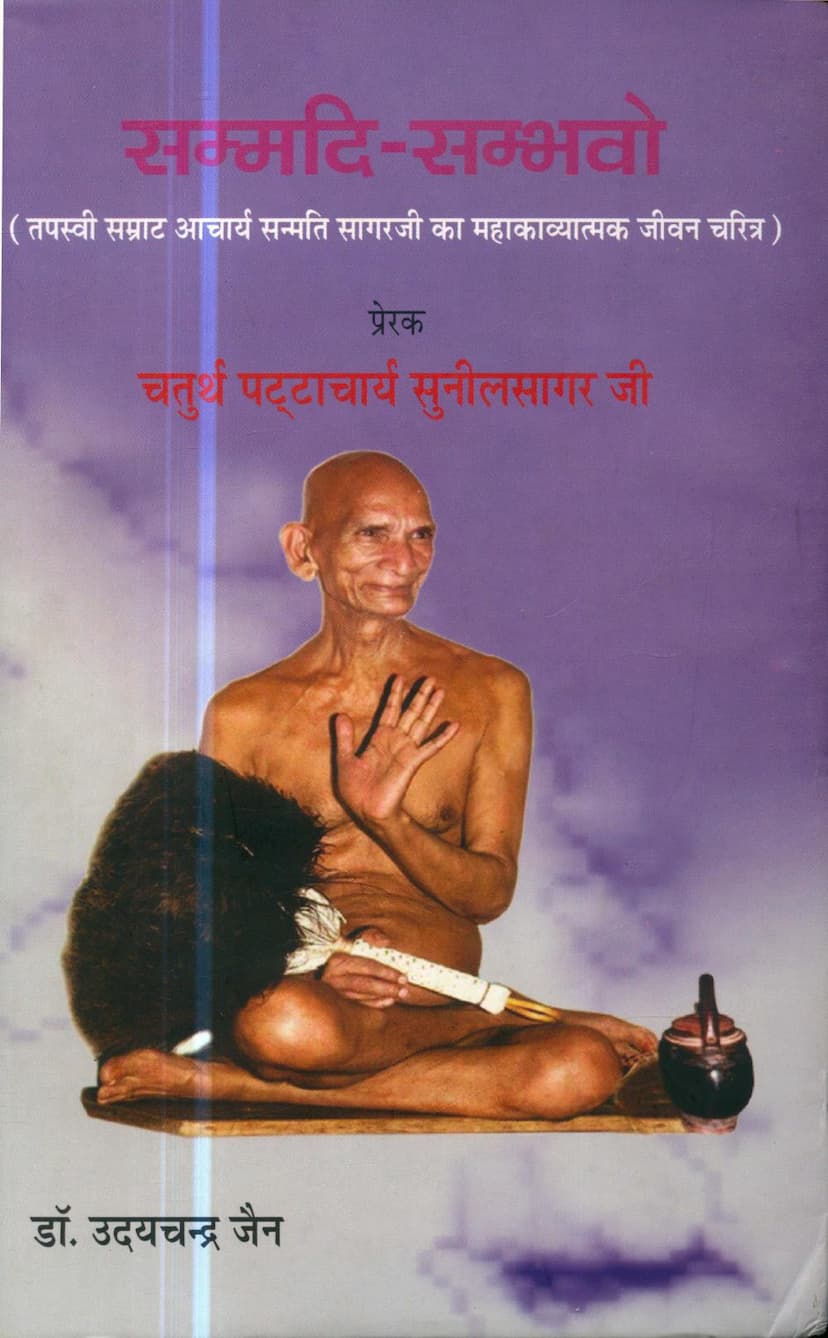Sammadi Sambhavo
Added to library: September 2, 2025

Summary
Here's a comprehensive summary of the Jain text "Sammadi Sambhavo" by Udaychandra Jain, based on the provided pages:
Book Title: Sammadi Sambhavo (सम्मदि-सम्भवो) Author: Dr. Udaychandra Jain Publisher: Bharatiya Jnanpith Subject: A Mahakavyatmak (epic poetic) biography of the great ascetic Acharya Shanmatisagarji Maharaj. Inspiration: Acharya Sunil Sagarji Maharaj (Chathurth Pattacharya)
Core Subject: "Sammadi Sambhavo" is a significant Mahakavya (epic poem) that chronicles the extraordinary life and spiritual journey of Acharya Shanmatisagarji Maharaj, a renowned ascetic of the Shraman tradition. The work, penned by Dr. Udaychandra Jain, is presented as a tribute to the profound austerities and spiritual achievements of Acharya Shanmatisagarji.
Acharya Shanmatisagarji Maharaj's Life and Achievements:
- Birth and Early Life: Born as Om Prakash in 1938 (Magh Shukla Saptami) in Faphotu village, Etah district, Uttar Pradesh, to Sethi Pyarelal and Shrimati Jaymala Jain.
- Diksha (Initiation): Received munidīkṣā (ascetic initiation) from Acharya Vimalasagarji Maharaj in 1962 at Sammed Shikharji.
- Spiritual Pursuits: Accepted the refuge of Acharya Mahavir Kirtiji (his guru's guru) during his second Chaturmas and commenced rigorous penance and spiritual pursuit.
- Acharya Pad (Pontiffship): Acharya Mahavir Kirtiji, receiving the Pattacharya post from his guru Acharya Adisagar (Akalikar), bestowed it upon Muni Shanmatisagarji three days before his own samadhi (nirvana) in 1972.
- Extreme Austerities (Tapasya):
- Renounced grains, salt, sugar, ghee, and oil in the latter half of his life.
- For the last ten years of his life, he survived by consuming buttermilk-water only once every 48 hours.
- Undertook over ten thousand fasting days without water (nirjal upavas).
- Contributions to the Jain Sangha:
- Initiated over 200 ascetics (diksha).
- Made over 1200 individuals vows (vratis).
- Literary and Other Aspects: Held numerous titles and authored many books.
- Samadhi (Nirvana): Achieved samadhi on December 24, 2010, in Kunjvan (Udgaon), Kolhapur district.
- Successor: Appointed Acharya Sunilsagarji as his successor.
The Mahakavya "Sammadi Sambhavo":
- Author: Dr. Udaychandra Jain, a scholar of Prakrit and a renowned Mahakavi (great poet), also honored with the titles of Ashukavi (quick poet) and Dwivagish (master of two languages).
- Inspiration: The work is inspired by the life and teachings of Acharya Shanmatisagarji, particularly the pratikramana (confession and repentance) from his guru Acharya Sunil Sagarji. Acharya Sunil Sagarji's work "Anutha Tapasvi" (Unique Ascetic) served as a basis.
- Language and Structure: Composed in Prakrit, following the tradition of Mahavir Swami's teachings. The poem is structured into fifteen chapters, each named 'Sammadi' (meaning 'good intellect' or 'right path').
- Content: The poem delves into various aspects of Acharya Shanmatisagarji's life, including:
- Praise of Rishabhanatha, Siddhas, and the Panch Parmeshthis (Preamble – Padmam Samadi).
- Descriptions of his family, birth, naming ceremony, temple visits, and general education (Second and Third Sammadi).
- His education, discipline, arts, acceptance of Brahmacharya vow, government service, pilgrimage to Sammed Shikhar, ascetic life, and initiation (Fourth Sammadi).
- His first Chaturmas, knowledge, meditation, austerities, and various pilgrimages (Fifth to Twelfth Sammadi).
- His final Chaturmas in Kolhapur (2010), disciple tradition, and Pancakalyanaks (Thirteenth to Fifteenth Sammadi).
- Literary Merit: The poem is rich in poetic embellishments, including extensive use of shlesh (pun) and other figures of speech like upama, rupak, yamak, utpreksha, deepak, vibhavana, and anupras. The primary rasa is Shanta (peace), with elements of Karuna (compassion) also present. The preferred meter of the poet is Vasantatilaka.
- Spiritual Essence: The Mahakavya emphasizes the importance of detachment (vairagya), the path to liberation (moksha), the renunciation of worldly pleasures, and the pursuit of spiritual knowledge, meditation, and austerities. It highlights the hero's dedication to spiritual goals and his unwavering commitment to the path of liberation.
Key Themes and Messages:
- The Power of Austerity (Tapasya): The life of Acharya Shanmatisagarji is presented as a testament to the transformative power of extreme austerities and self-discipline.
- Spiritual Dedication: The poem celebrates unwavering devotion to spiritual pursuits, detachment from worldly comforts, and the relentless quest for self-realization.
- Guidance for the Spiritual Path: "Sammadi Sambhavo" serves as a guide for those seeking the path of renunciation and spiritual liberation.
- Revival of Prakrit: The author, Dr. Udaychandra Jain, advocates for the revival and continued use of the Prakrit language, seeing it as a vital link to the ancient teachings of Mahavir and Buddha. The very act of writing this epic in Prakrit contributes to its preservation and resurgence.
- Legacy of Asceticism: The work immortalizes the exemplary life of Acharya Shanmatisagarji, offering inspiration and a model for future generations of Jains.
Publisher and Edition: The book is published by Bharatiya Jnanpith and its first edition was released in 2018.
In essence, "Sammadi Sambhavo" is not merely a biography; it is an epic devotional ode rendered in classical Prakrit, celebrating the life of a monumental Jain ascetic and embodying the core principles of Jain philosophy and practice.